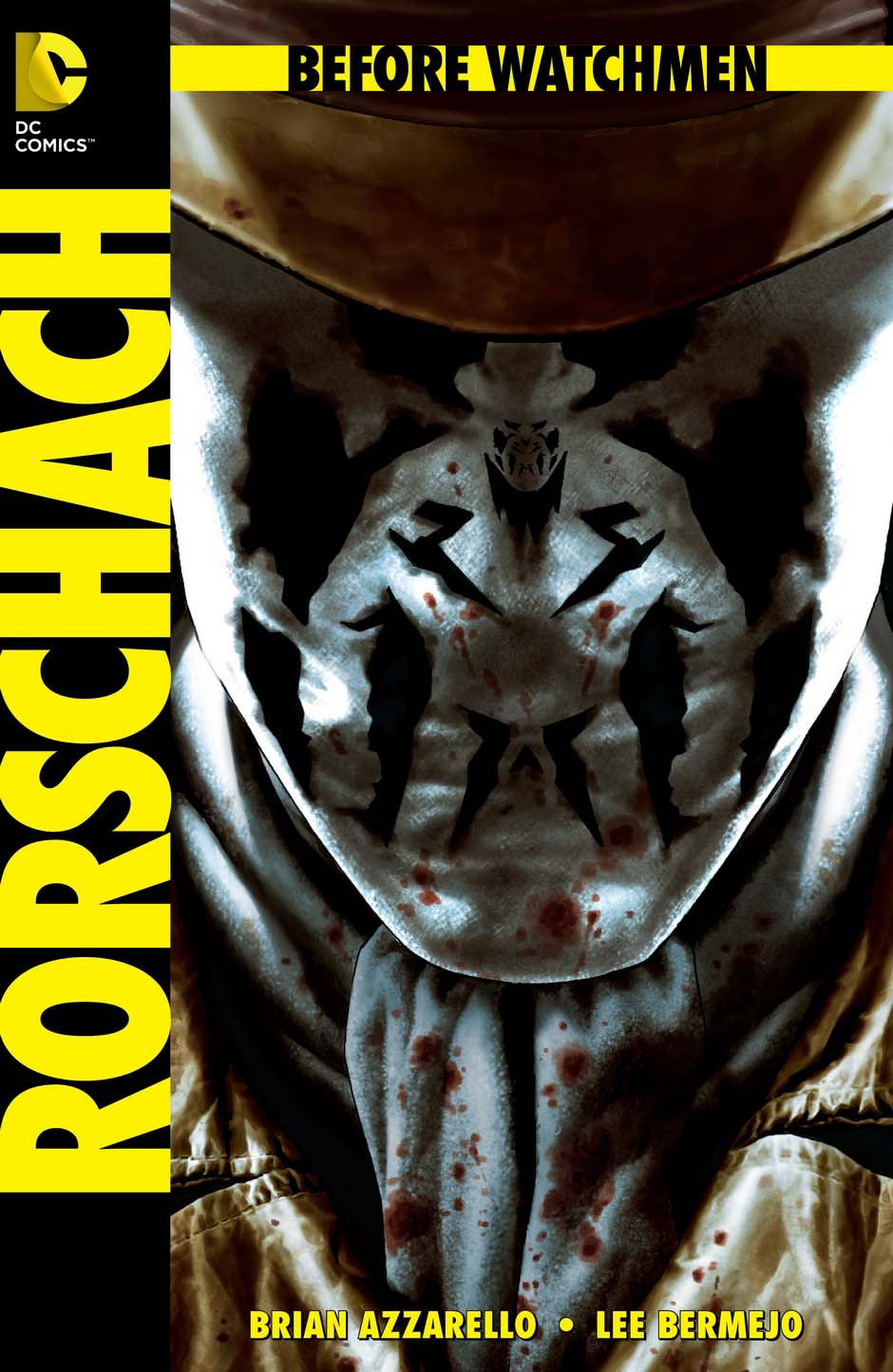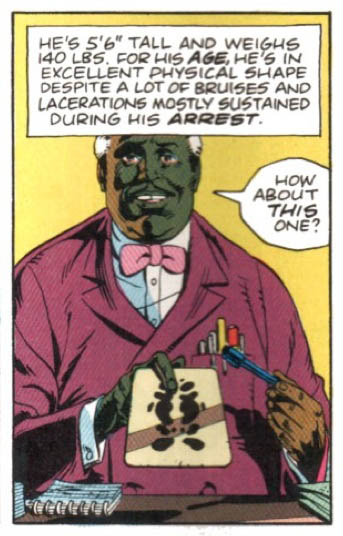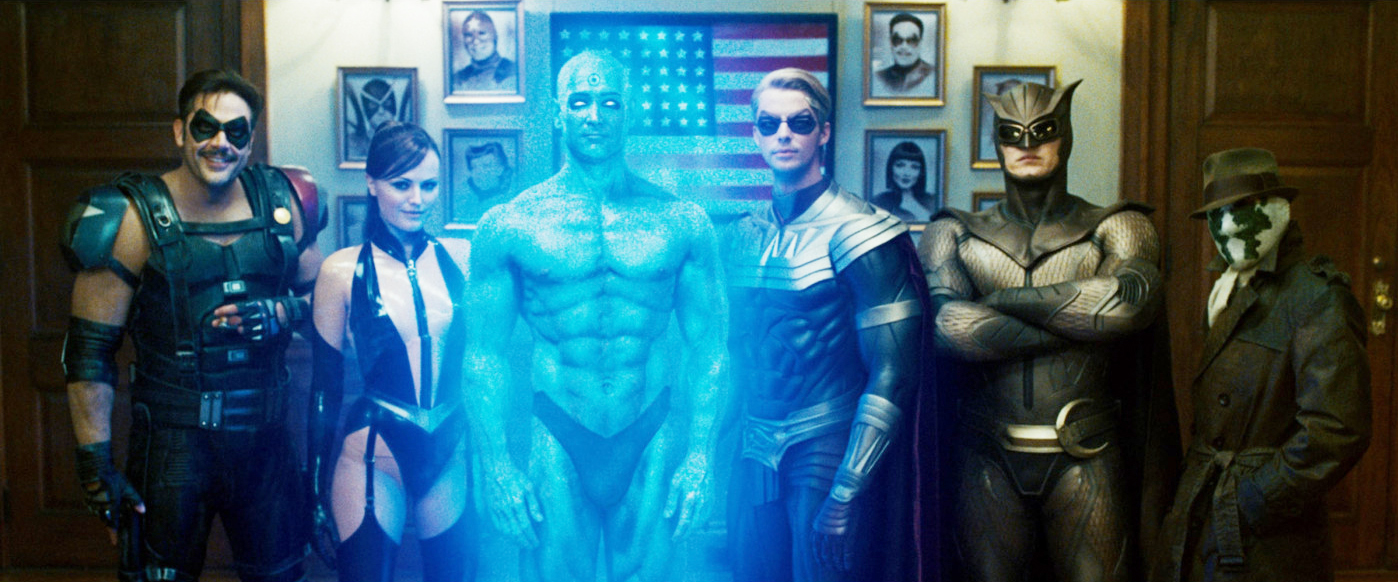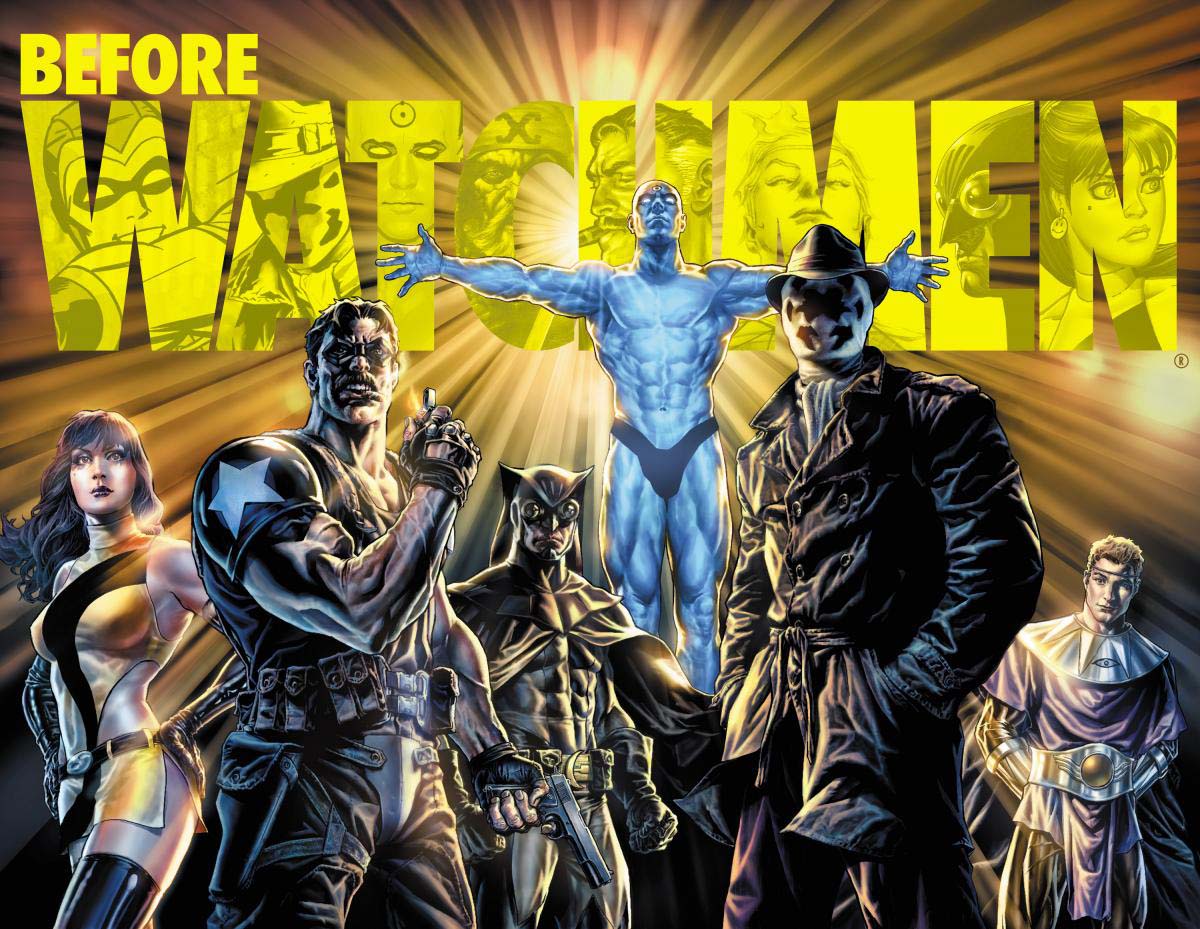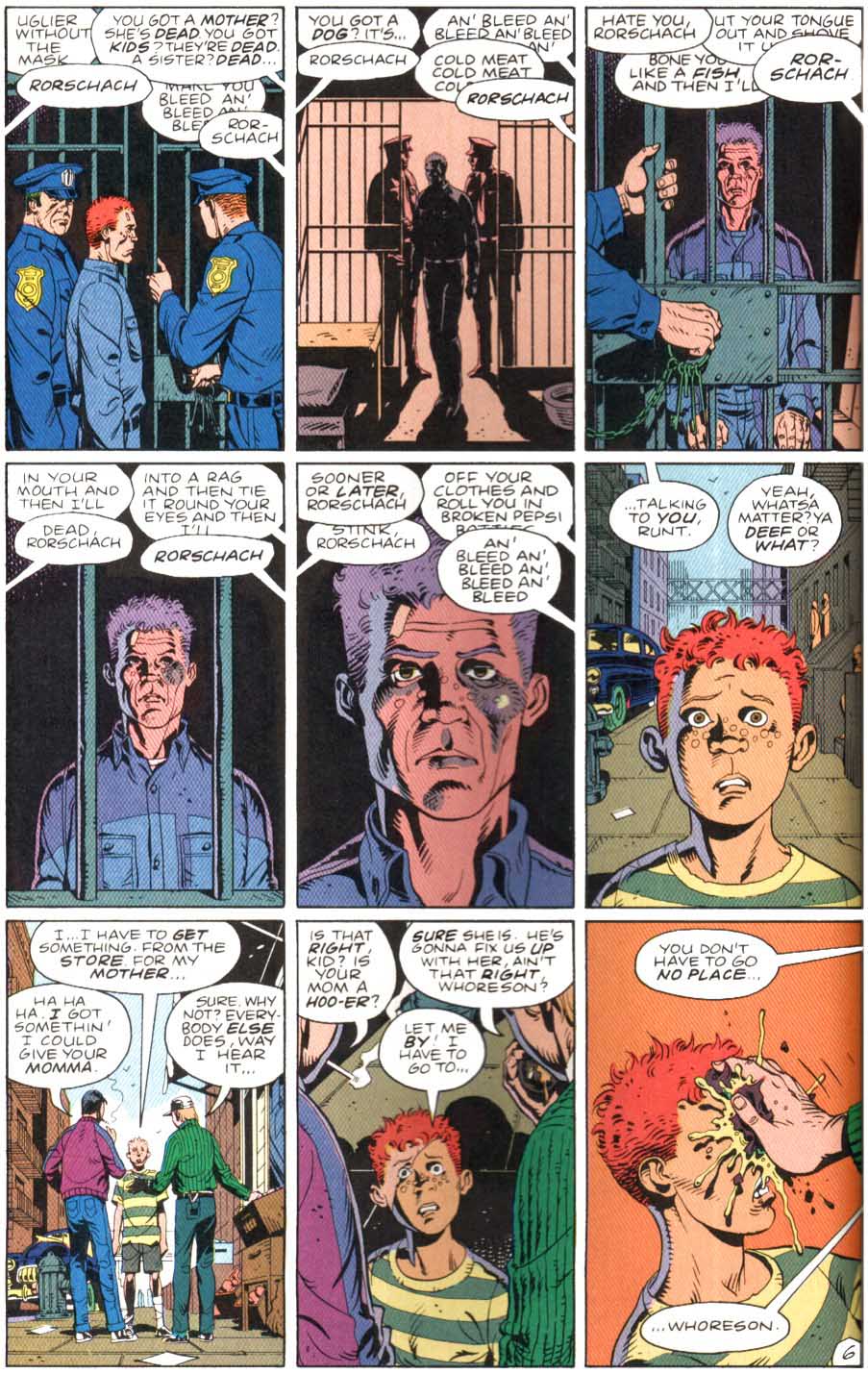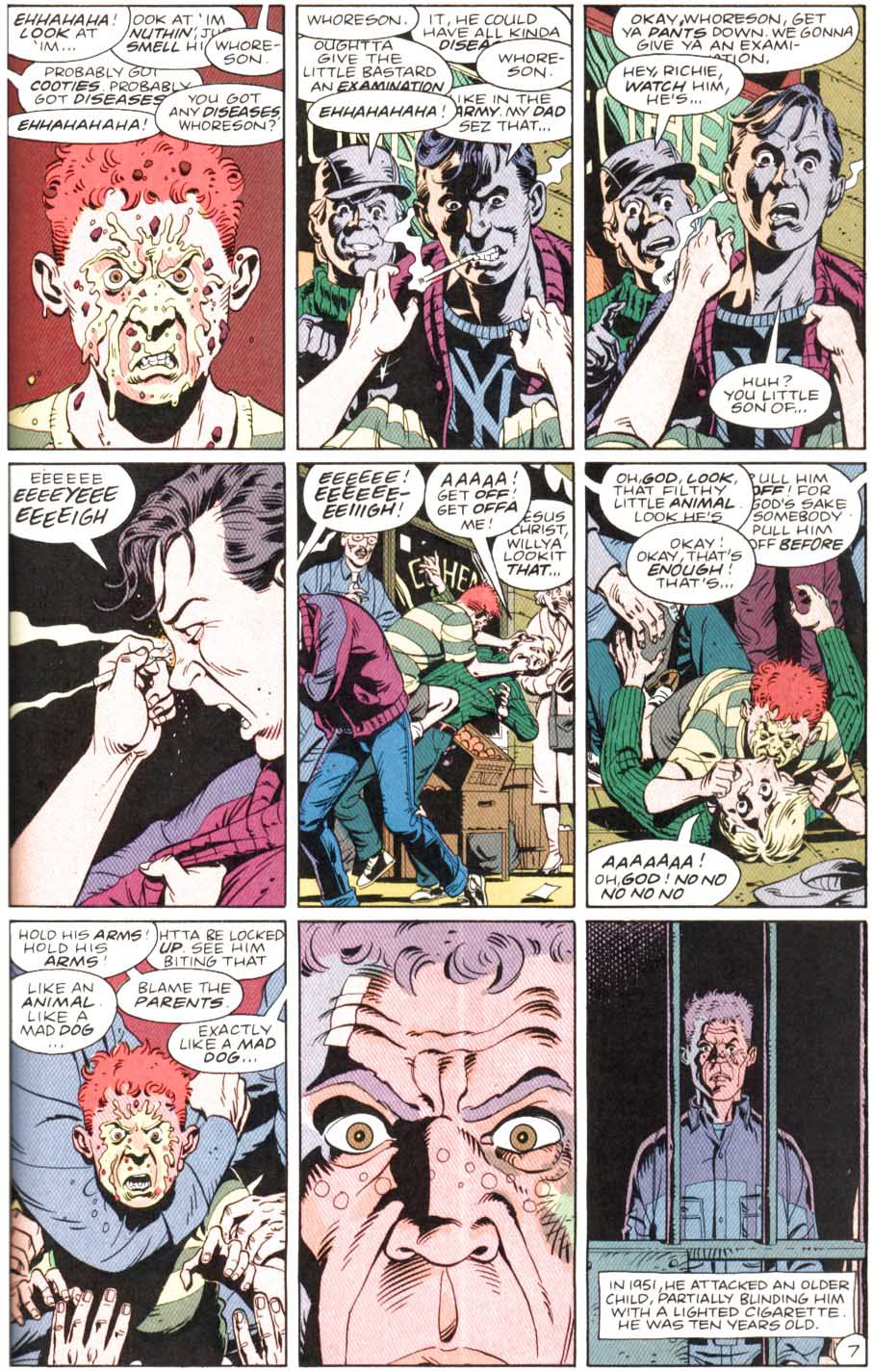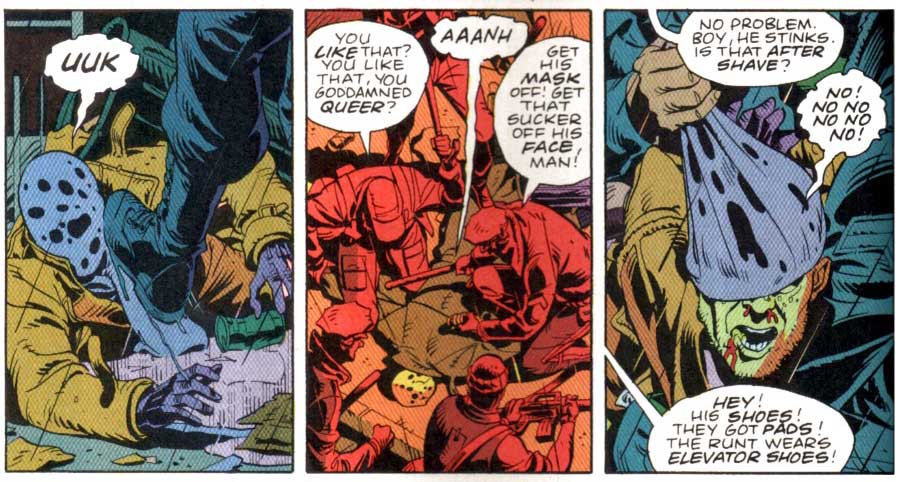I can’t quite summon the kind of tooth-grinding indignation over the very concept of DC’s Watchmen prequels that I think I probably should, because, when I was a sixteen-year-old reading Watchmen for the first time, I remember wishing earnestly that American comics had a doujinshi subculture. (It would be more than a decade before Tumblr came along.) Setting aside—not that we should do so for long—corporate exploitation of artists, the difference, it seems to me, between doujinshi and DC’s prequels lies mostly in the profit margin. Watchmen doujinshi, had they existed, would’ve almost certainly been unsanctioned by Alan Moore, and I would’ve bought them anyway.
So it would feel a bit hypocritical for me to dismiss the prequels out of hand. I’m more troubled by the idea that they might be lousy than by the sheer fact that they exist. Recently released images, however, do not fill me with optimism.
For one thing, Lee Bermejo seems not to have realized that Rorschach is short.
He has, according to the script, the physique of Buster Keaton. Of course, Dave Gibbons didn’t draw Rorschach short either; I have immense respect for Gibbons’ achievement on Watchmen, but when asked to deviate from heroic proportions, he just couldn’t manage. All his adults are tall and broad. On the other hand, Zack Snyder, who for all his flaws showed an impressive grasp of the granular details that comprise Watchmen’s world, cast a 5’6″ actor, and—even more remarkable—framed him next to taller actors and let him look short.
If Snyder, whose films indicate that he has the moral and aesthetic intelligence of an eleven-year-old, could get Rorschach’s body right, what’s holding DC back?
I’m not very familiar with Bermejo’s work and I don’t mean to trash him; taken on its own merits, the Rorschach cover is a clever conceit gracefully executed. But a comic book illustrator’s job is to build a world, and the story’s world starts at the protagonist’s body.
Rorschach’s height is important. It sets him apart from the others. I’m 5’6″, and I am not a physically intimidating presence in most situations. Unlike the other male crimefighters in Watchmen, and most male superheroes in general, Rorschach doesn’t have overpowering physical size as an automatic advantage. His defining characteristic in battle is resourcefulness; we see him fight with improvised weapons over and over again—a cigarette, a rag, a can of hairspray. He needs them; he has to be faster and smarter.
I’m afraid that this looming, broad-shouldered Rorschach is the canary in the coal mine.
The differences between Watchmen and other superhero books are much greater than a little nudity and a little moral ambivalence. It is a delicate, subtle story whose spirit is easily betrayed. For an example, let’s look at Zack Snyder’s version of a pivotal scene from chapter 6.
FLASH OF: Rorschach as a little boy looking up at TWO OLDER BOYS, teasing him. Calling him “son of a whore.” Rorschach just wants to be left alone when one of the Boys SPITS in his face. Suddenly, Rorschach’s face changes. He attacks the Boy like a wild animal–biting, clawing.
This is a formative moment for Walter, in both film and book: it’s the first act of violence we ever see him commit. In the film, he’s motivated by an insult to his pride. In the book, it’s quite different:
As a teenage girl reading Watchmen I was stunned by this scene. Never before in my travels through fiction had I seen a male character—a male protagonist—have to fear and defend himself against sexual assault. And that’s what it is; the threat the boy is making just before Walter burns out his eye is an unmistakably sexual one: “Get ya pants down.”
I wonder why Snyder and his team changed that scene. Did the generic, truncated version really seem like an improvement to them? Was it merely a cut for time? Or is attempted rape a trauma that heroes do not suffer?
Like Rorschach’s height, this is more than a minor point of characterization to me. The book puts a lot of emphasis on Rorschach’s hatred of his mother, and his associated disgust and fear of female sexuality, but if his mother were the beginning and end of the problem, one would expect him to attack prostitutes. That’s not what he does. He uses violent and misogynistic language, and as a result, many readers see him as willing and able to physically hurt women—but we never actually see that happen, nor are there any references to off-panel incidents. Except in the flashback scene in which his mother hits him, Rorschach never has any physical contact with a woman at all. Who does he target when he’s under the mask?
Of the two murders he admits to after he’s arrested, one is Gerald Grice, the man who butchered Blaire Roche. Take note of the sexual connotations of that episode: it’s not a little girl’s shirt or shoe Rorschach finds in the wood stove—it’s a fragment of underwear. The other is Harvey Charles Furniss, a serial rapist. And one of the few moments of satisfaction, or even something approaching happiness, Rorschach gets in the book happens on page 18 of chapter 5, where he interrupts a rape attempt in an alley: The man turned and there was something rewarding in his eyes. Sometimes, the night is generous to me.
He’s disgusted by women who are sexually active, but his targets, the people he attacks with the most unrestrained violence, are sexually-abusive men. I think Rorschach can actually be read as a rape victim.
Think about his history: he spent his early childhood in a home to which adult male strangers had frequent access, then was placed in an institution. And there are strong overtones of gang rape in the final page of chapter 5:
He’s beaten and held down by a group of men who strip him forcibly, insult his body and sexuality, and suggest that he’s enjoying it—note the cop’s line in panel 5: “You like that? You like that, you goddamned queer?”
But, one might ask, what about his apparent lack of sympathy for Sally as Edward Blake’s victim, which made Laurie so angry in chapter 1 (“I’m not here to speculate on the moral lapses of men who died in their country’s service. I came to warn…” “Moral lapses? Rape is a moral lapse?”), and which would appear to contradict my interpretation of the character? I have three ways of looking at this:
1) Alan Moore was flying by the seat of his pants to a certain extent. Half the series was drawn, lettered, printed and on the stands before the last chapter was even written. He’s said in interviews that it was when he was writing chapter 3 that he realized how Rorschach’s story would end; it wasn’t until that point that he really saw inside the character. His initial intention was for Rorschach to be completely unsympathetic, which end is furthered by the scene in chapter 1 with Laurie and Dr. Manhattan; when he wrote that, he probably didn’t have Rorschach’s backstory worked out.
The disorganized, intuitive fashion in which Moore developed his characters is demonstrated by this interview in which he’s asked why Rorschach takes his mask off in chapter 12:
I’m not sure, it just seemed right. I mean, a lot of these things you just—I kind of felt that’s what he’d do. I don’t know, I don’t know why. I couldn’t logically say why the character should do that but it just felt right… I couldn’t really explain why I did it, it just seemed like what I’d do if I was Rorschach, which is the only way that I can really justify the actions of any of the characters.
So, some disconnect between earlier and later chapters can, in theory, be explained by the serial nature of the book’s publication and the impossibility of late-stage rewrites, although this isn’t my preferred explanation.
2) As I mentioned above, Rorschach fears and loathes women who express their sexuality openly. He refers to Sally in his journal as a “whore”; in his perception, she falls into the category of Bad Women—whether there really are any Good Women in his world is an unanswerable question, although his attitude toward Laurie is less negative—and he is unable to acknowledge her as an innocent victim, like Blaire Roche or the woman in the alley. Or Walter Kovacs.
Also, he liked the Comedian, when they met at the Crimebusters meeting in 1965, and seems inclined to believe the best about him. It’s hard to prove, but I think Rorschach conflates Edward Blake with his father—”men who died in their country’s service”—similar to, although less explicit than, his conflation of his father and Harry Truman. His support of Blake despite abundant evidence that Blake doesn’t deserve it is one of his defensive illusions.
3) The things that Rorschach says do not line up with the things he does.
Throughout the book, though most noticeably in chapters 1 and 6, Rorschach talks in his journal about the hideousness of humanity in general and New York in specific, how much it disgusts him, and how eagerly he’s looking forward to some kind of apocalypse that would wipe the slate clean. In chapter 12, he gets his wish, and he breaks down in tears.
In my opinion, his reaction to Veidt’s catastrophe proves that everything he says on the first page is self-deception. He wouldn’t whisper No. What he says about humanity in his journal and to Dr. Long is part of his attempt, ongoing since at least 1975, to kill the vulnerable part of himself, the part that loved and felt pain, the part that was helpless and afraid. In the end, he fails, and walks forward, weeping, into his own death.
Let’s talk for a minute about 1975.
Here’s another change Snyder made: the removal of the line, “Mother.” In the book, this is the last word Walter Kovacs ever speaks—at least until page 24 of chapter 12. It’s a strange, loaded, exposed moment, and in the movie it’s not there.
Violence against children and rape are Rorschach’s triggers. The former is made explicit by the dialogue on page 18 of chapter 6, as Rorschach sets up the scene for Dr. Long: “Days dragged by, no word from kidnappers. Thought of little child, abused, frightened. Didn’t like it. Personal reasons.” I think we can infer the latter from the argument I made above. The murder and implied sexual abuse of Blaire Roche combines both triggers in a particularly horrific way, and drags Rorschach back into the childhood he put on the mask to escape.
Blaire Roche has become Walter Kovacs in that moment when he closes his eyes. He is the child who was abused and frightened, butchered and consumed, and “Mother” is a plea for help and an accusation: “Why didn’t you protect me? How could you let these things happen?”
The foundation of Rorschach is in powerlessness, and those are the parts of his story that Snyder chose to excise. I don’t want to see that happen again.
Rorschach matters a lot to me. I have never felt any comparable level of emotional connection to a character in a superhero comic. I’m not anti-cape; there are some superhero books I like, for a variety of reasons—but my emotional investment remains minimal. Whatever need lives in the heart of the superhero fantasy is, apparently, a need I do not share.
But to be knocked down and get up again, to demand the humanity you’ve been denied—I can understand that. Rorschach is a portrait of the body under threat, and, even more crucially, a portrait of resistance to which I can directly relate. I am a pacifist; I do not condone violence; but I also have some understanding of trauma: the feeling of helplessness, the shame, the rage.
Of course, my reading of Rorschach is only my reading. I make no claim to be objectively correct in every point; I have not read Alan Moore’s mind; I don’t expect or demand that every Watchmen reader will agree with me. But I think we can agree that Rorschach is, for better or worse, not just another comic book crimefighter, and I dread DC reducing him to that: just another brawny beast of a man with heroic proportions and nothing to fear.

